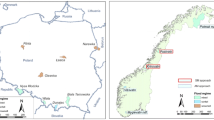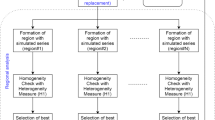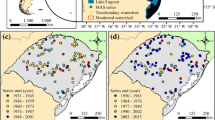Abstract
In flood frequency analysis, a suitable probability distribution function is required in order to establish the flood magnitude-return period relationship. Goodness of fit (GOF) techniques are often employed to select a suitable distribution function in this context. But they have been often criticized for their inability to discriminate between statistical distributions for the same application. This paper investigates the potential utility of subsampling, a resampling technique with the aid of a GOF test to select the best distribution for frequency analysis. The performance of the methodology is assessed by applying the methodology to observed and simulated annual maximum (AM) discharge data series. Several AM series of different record lengths are used as case studies to determine the performance. Numerical analyses are carried out to assess the performance in terms of sample size, subsample size and statistical properties inherent in the AM data series. The proposed methodology is also compared with the standard Anderson–Darling (AD) test. It is found that the methodology is suitable for a longer data series. A better performance is obtained when the subsample size is taken around half of the underlying data sample. The methodology has also outperformed the standard AD test in terms of effectively discriminating between distributions. Overall, all results point that the subsampling technique can be a promising tool in discriminating between distributions.









Similar content being viewed by others
References
Ahmad MI, Sinclair CD, Spurr BD (1988a) Assessment of flood frequency models using empirical distribution function statistics. Water Resour Res 24:1323. doi:10.1029/WR024i008p01323
Ahmad MI, Sinclair CD, Werritty A (1988b) Log-logistic flood frequency analysis. J Hydrol 98:205–224
Anderson TW, Darling DA (1952) Asymptotic theory of certain “goodness of fit” criteria based on stochastic processes. Ann Math Stat 23:193–212. doi:10.1214/aoms/1177733256
Arshad M, Rasool MT, Ahmad MI (2003) Anderson Darling and modified Anderson Darling tests for generalized Pareto distribution. Pak J Appl Sci 3(2):85–88
Bickel PJ, Sakov A (2008) On the choice of m in the m out of n bootstrap and confidence bounds for extrema. Stat Sin 18:967–985
Burn DH (2003) The use of resampling for estimating confidence intervals for single site and pooled frequency analysis/Utilisation d’un rééchantillonnage pour l’estimation des intervalles de confiance lors d’analyses fréquentielles mono et multi-site. Hydrol Sci J 48:25–38. doi:10.1623/hysj.48.1.25.43485
Chernick MR (2011) Bootstrap methods: a guide for practitioners and researchers. Wiley, New York
Cunnane C (1978) Unbiased plotting positions—a review. J Hydrol 37:205–222. doi:10.1016/0022-1694(78)90017-3
Cunnane C (1989) Statistical distributions for flood frequency analysis. Operational Hydrology Report (WMO), Geneva
Das S (2010) Examination of flood estimation techniques in the Irish context, Ph.D. thesis. Department of Engineering Hydrology, National University of Ireland Galway. http://hdl.handle.net/10379/1688. Accessed 30 Oct 2015.
Das S, Cunnane C (2011) Examination of homogeneity of selected Irish pooling groups. Hydrol Earth Syst Sci 15:819–830. doi:10.5194/hess-15-819-2011
Das S, Cunnane C (2012) Performance of flood frequency pooling analysis in a low CV context. Hydrol Sci J 57:433–444. doi:10.1080/02626667.2012.666635
Das S, Simonovic SP (2012) Assessment of uncertainty in flood flows under climate change impacts in the Upper Thames River Basin, Canada. Br J Environ Clim Chang 2:318–338
Das S, Millington N, Simonovic SP (2013) Distribution choice for the assessment of design rainfall for the city of London (Ontario, Canada) under climate change. Can J Civ Eng 40:121–129. doi:10.1139/cjce-2011-0548
Di Baldassarre G, Laio F, Montanari A (2009) Design flood estimation using model selection criteria. Phys Chem Earth A/B/C 34:606–611. doi:10.1016/j.pce.2008.10.066
Efron B (1979) Bootstrap methods: another look at the jackknife. Ann Stat 7:1–26
Green BF (1977) FORTRAN subroutines for random sampling without replacement. Behav Res Methods Instrum 9:559. doi:10.3758/BF03214009
Greenwood JA, Landwehr JM, Matalas NC (1979) Probability weighted moments: definition and relation to parameters of several distributions expressable in inverse form. Water Resour Res 15:1049–1054
Haddad K, Rahman A (2010) Selection of the best fit flood frequency distribution and parameter estimation procedure: a case study for Tasmania in Australia. Stoch Environ Res Risk Assess 25:415–428. doi:10.1007/s00477-010-0412-1
Hall MJ, van den Boogaard HFP, Fernando RC, Mynett AE (2004) The construction of confidence intervals for frequency analysis using resampling techniques. Hydrol Earth Syst Sci 8:235–246. doi:10.5194/hess-8-235-2004
Hosking JRM (1990) L-moments: analysis and estimation of distributions using linear combinations of order statistics. J R Stat Soc 52:105–124
Hosking JRM, Heights Y (2005) Research Report Fortran routines for use with the method of. Mathematics 20525:33
Hosking JRM, Wallis JR (1997) Regional frequency analysis: an approach based on L-moments. Cambridge University Press, Cambridge
Hosking JRM, Wallis JR, Wood EF (1985) Estimation of the generalized extreme-value distribution by the method of probability-weighted moments. Technometrics 27:251–261
Institute of Hydrology (1999) Flood estimation handbook, vol 5. Institute of Hydrology, Wallingford, UK
Jingyi Z, Hall MJ (2004) Regional flood frequency analysis for the Gan-Ming River basin in China. J Hydrol 296:98–117. doi:10.1016/j.jhydrol.2004.03.018
Kolmogorov A (1933) Grundbegriffe der Wahrscheinlichkeitsrechnung. Springer, Berlin
Laio F (2004) Cramer-von Mises and Anderson-Darling goodness of fit tests for extreme value distributions with unknown parameters. Water Resour Res 40:1–10. doi:10.1029/2004WR003204
Laio F, Di Baldassarre G, Montanari A (2009) Model selection techniques for the frequency analysis of hydrological extremes. Water Resour Res 45:1–11. doi:10.1029/2007WR006666
Lall U, Sharma A (1996) A nearest neighbor bootstrap for resampling hydrologic time series. Water Resour Res 32:679–693
Liu YH, Liang Z, Liu Y et al (2015) Uncertainty assessment of estimation of hydrological design values. Stoch Env Res Risk Assess 29:501–511. doi:10.1007/s00477-014-0979-z
NERC (1975) Flood studies report. Natural Environment Research Council, London
Önöz B, Bayazit M (1995) Best-fit distributions of largest available flood samples. J Hydrol 167:195–208. doi:10.1016/0022-1694(94)02633-M
Onyutha C (2016) Identification of sub-trends from hydro-meteorological series. Stoch Environ Res Risk Assess. doi:10.1007/s00477-015-1070-0
Onyutha C, Willems P (2015) Uncertainty in calibrating generalised Pareto distribution to rainfall extremes in Lake Victoria basin. Hydrol Res 46:356–376
Ouali D, Chebana F, Ouarda TBMJ (2016) Non-linear canonical correlation analysis in regional frequency analysis. Stoch Environ Res Risk Assess 30:449–462. doi:10.1007/s00477-015-1092-7
Pandey MD, Gelder PV, Vrijling JM (2001) Assessment of an L-kurtosis-based criterion for quantile estimation. J Hydrol Eng 6:284–292. doi:10.1061/(ASCE)1084-0699(2001)6:4(284)
Politis DN, Romano JP (1994) Large sample confidence regions based on subsamples under minimal assumptions. Ann Stat 22:2031–2050. doi:10.1214/aos/1176325770
Politis DN, Romano JP (2010) K-sample subsampling in general spaces: the case of independent time series. J Multivar Anal 101:316–326. doi:10.1016/j.jmva.2008.11.005
Politis DN, Romano JP, Wolf M (1999) Subsampling. Springer, New York
Politis DN, Romano JP, Wolf M (2001) On the asymptotic theory of subsampling. Stat Sin 11:1105–1124
Potter KW, Lettenmaier DP (1990) A comparison of regional flood frequency estimation methods using a resampling method. Water Resour Res 26:415. doi:10.1029/WR026i003p00415
Sankarasubramanian A, Srinivasan K (1999) Investigation and comparison of sampling properties of L-moments and conventional moments. J Hydrol 218:13–34. doi:10.1016/S0022-1694(99)00018-9
Smirnov NV (1936) Sur la Distribution de W2. Comp Rend Acad Sci 202:449–452
Stephens M (1986) Tests based on EDF statistics. In: D’Agostino RB, Stephens MA (eds) Goodness-of-fit techniques. Marcel Dekker Inc., New York
Tasker GD, Dunne P (1997) Bootstrap position analysis for forecasting low flow frequency. J Water Resour Plan Manag 123:359–367
USGS (1982) Guidelines for determining flood-flow frequency: Bulletin 17B of the Hydrology Subcommittee. Reston, VA, Office of Water Data Coordination, U.S. Geological Survey
Vogel RM (1986) The probability plot correlation coefficient test for the normal, lognormal, and Gumbel distributional hypotheses. Water Resour Res 22:587–590. doi:10.1029/WR022i004p00587
Vogel RM, Fennessey NM (1993) L moment diagrams should replace product moment diagrams. Water Resour Res 29:1745–1752
Wang Y, McBean EA, Jarrett P (2015) Identification of changes in heavy rainfall events in Ontario. Stoch Environ Res Risk Assess, Canada. doi:10.1007/s00477-015-1085-6
Yan H, Moradkhani H (2014) A regional Bayesian hierarchical model for flood frequency analysis. Stoch Environ Res Risk Assess. doi:10.1007/s00477-014-0975-3
Zucchini W, Adamson PT (1989) Bootstrap confidence intervals for design storms from exceedance series. Hydrol Sci J 34:41–48
Acknowledgments
The author would like to acknowledge the financial support in the form of a faculty start-up fund made available by the School of Hydrometeorology, Nanjing University of Information Science and Technology (NUIST), Nanjing, China. The observed annual maximum flood data series of selected stations were obtained freely from the Centre for Ecology & Hydrology (CEH), UK website: http://www.ceh.ac.uk/data/nrfa/data.
Author information
Authors and Affiliations
Corresponding author
Rights and permissions
About this article
Cite this article
Das, S. An assessment of using subsampling method in selection of a flood frequency distribution. Stoch Environ Res Risk Assess 31, 2033–2045 (2017). https://doi.org/10.1007/s00477-016-1318-3
Published:
Issue Date:
DOI: https://doi.org/10.1007/s00477-016-1318-3




